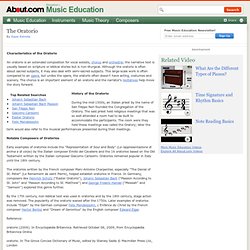

Oratorio. History[edit] 1600, origins of the oratorio[edit] Although medieval plays such as the Ludus Danielis, and Renaissance dialogue motets such as those of the Oltremontani had characteristics of an oratorio, the first oratorio is usually seen as Emilio de Cavalieri's Rappresentatione di Anima, et di Corpo.

Monteverdi composed Il Combattimento di Tancredi e Clorinda which can be considered as the first secular oratorio. 1650–1700[edit] By the mid-17th century, two types had developed: Lasting about 30–60 minutes, oratorio volgares were performed in two sections, separated by a sermon; their music resembles that of contemporary operas and chamber cantatas. oratorio latino (in Latin) – first developed at the Oratorio del Santissimo Crocifisso, related to the church of San Marcello al Corso in Rome.
The late baroque oratorio[edit] In the late baroque oratorios increasingly became "sacred opera". The oratorio in Georgian Britain[edit] The Victorian oratorio[edit] 20th-century oratorios[edit] Baroque sacred music - oratorio. Baroque era is known for its several grand forms of church music, including the passion, the oratorio, or the cantata.

They were all based on texts refering to the sacred religious book (Bible), although the setting was different between these three music forms. The passion was based on Jesus' suffering and was based on the Gospel texts, the Oratorio was more poetic and could be about any other Biblical story, while cantatas were based on Biblical texts. It is quite remarkable that in the midst of separation between the sacred and the secular, composers wrote for both of the worlds.
They didn't necessarily fought on either side of the schism. And that's understandable since they wanted to get famous, or saw it as a way to get jobs or get paid by different employers (even the Protestant J.S. A standard device that was used to accompany the singers in the church music, but that was borrowed from the opera, was basso continuo.
Home Theory Science Sheet Music E-zine Contact us. The Oratorios of Handel. Background The Italian Baroque oratorio was hardly anything other than an opera on a sacred subject, presented in concert instead of on the stage.

This conception is an essential element of Handel's oratorios. Most of the arias in these works differ in no important respects -- neither in form, musical style, nature of the musical ideas, nor technique of expressing affects -- from the arias in his operas. As in the operas also, the mood of each aria is usually prepared, and the aria introduced, by a preceding recitative.
But there are alterations and additions which transform the oratorios into something different from the conventional 18th-century opera. Librettos Fundamental is the fact that Handel's oratorio librettos were in English. Function and Form The oratorios are not to be regarded as church music. Handel's Choral Style Works La Resurrezione (1708)Ode for St.
(See also The Oratorio) The Oratorio - History and Composers of Oratorios. Characteristics of the Oratorio An oratorio is an extended composition for vocal soloists, chorus and orchestra; the narrative text is usually based on scripture or biblical stories but is non-liturgical.

Although the oratorio is often about sacred subjects, it may also deal with semi-sacred subjects. This large-scale work is often compared to an opera, but unlike the opera, the oratorio often doesn't have acting, costumes and scenery. The chorus is an important element of an oratorio and the narrator's recitatives help move the story forward. YouTube. YouTube. YouTube.